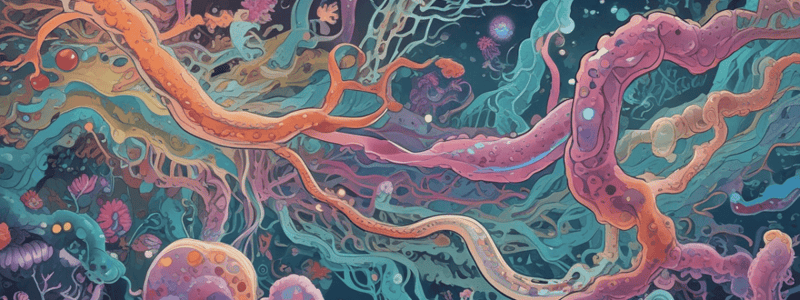Podcast
Questions and Answers
What is a characteristic of the genus Escherichia?
What is a characteristic of the genus Escherichia?
- Obligate anaerobic
- Facultative anaerobic (correct)
- Microaerophilic
- Obligate aerobic
What is a virulence factor of E. coli?
What is a virulence factor of E. coli?
- Endotoxin (correct)
- Exotoxin
- Hemolysin
- Cytotoxin
What is a habitat of Salmonella?
What is a habitat of Salmonella?
- Gut of animals (correct)
- Human skin
- Soil
- Fresh water
What is a characteristic of Vibrio?
What is a characteristic of Vibrio?
What is a symptom of Salmonella infection?
What is a symptom of Salmonella infection?
What is a transmission route of E. coli?
What is a transmission route of E. coli?
What is a characteristic of S. typhi?
What is a characteristic of S. typhi?
What is a characteristic of E. coli's flagella?
What is a characteristic of E. coli's flagella?
Which of the following bacteria can cause meningitis?
Which of the following bacteria can cause meningitis?
What is a characteristic of Rickettsia?
What is a characteristic of Rickettsia?
How is Rickettsia typically transmitted?
How is Rickettsia typically transmitted?
What is a common symptom of meningitis?
What is a common symptom of meningitis?
What is a characteristic of Rickettsia prowazekii?
What is a characteristic of Rickettsia prowazekii?
What type of stain is used to visualize Neisseria gonorrhoeae?
What type of stain is used to visualize Neisseria gonorrhoeae?
What is the primary characteristic of Vibrio cholerae that enables it to cause severe diarrhoea?
What is the primary characteristic of Vibrio cholerae that enables it to cause severe diarrhoea?
Which of the following is a characteristic of Pseudomonas aeruginosa?
Which of the following is a characteristic of Pseudomonas aeruginosa?
What is the primary mode of transmission of Vibrio cholerae?
What is the primary mode of transmission of Vibrio cholerae?
What is the primary function of the capsule in Neisseria species?
What is the primary function of the capsule in Neisseria species?
Which of the following is NOT a characteristic of Vibrio cholerae?
Which of the following is NOT a characteristic of Vibrio cholerae?
What is the primary function of fimbriae in Neisseria species?
What is the primary function of fimbriae in Neisseria species?
What is the primary reason for Pseudomonas aeruginosa being an opportunistic pathogen?
What is the primary reason for Pseudomonas aeruginosa being an opportunistic pathogen?
What is the primary source of Pseudomonas aeruginosa infections?
What is the primary source of Pseudomonas aeruginosa infections?
Flashcards are hidden until you start studying
Study Notes
Gram-Negative Bacteria
Proteobacteria
-
Escherichia (E. coli) is a heterotrophic, facultative anaerobic, Gram-negative rod-shaped bacterium that inhabits the gut of humans and animals.
-
It can cause diarrhea, fever, and produces endotoxin and enterotoxin (in some strains).
-
E. coli is part of the Enterobacteriaceae family and has peritrichous flagella for motility.
-
Most strains are normal flora, but some can be pathogenic, with infection occurring through animal contact or contaminated food (e.g., 0157, 0111).
-
Salmonella (S. enterica) is a heterotrophic, facultative anaerobic, Gram-negative rod-shaped bacterium that is a normal flora in animal gut.
-
It can cause food-borne infections and self-limiting diarrhea, with endotoxin and enterotoxin production.
-
S. typhi is a water-borne infection that causes typhoid fever, which can be fatal.
Vibrio
- Vibrio (V. cholera) is a heterotrophic, facultative anaerobic, Gram-negative curved rod-shaped bacterium that is mainly found in marine environments.
- It can cause gut infections, cholera, and severe diarrhea, with exotoxin production.
- V. cholera is often found in sewage contamination and can cause seafood-borne disease.
Pseudomonas
- Pseudomonas (P. aeruginosa) is a heterotrophic, aerobic, Gram-negative curved rod-shaped bacterium that is commonly found in soil and water.
- It can cause hospital-acquired infections, such as burns and contact lenses infections, and has innate antibiotic resistance.
- P. aeruginosa has low membrane permeability, produces haemolysin, and proteases, and has a large genome (6mb) making it metabolically versatile.
Neisseria
- Neisseria is a heterotrophic, aerobic, Gram-negative diplococci bacterium that inhabits mammalian mucous membranes.
- It has a capsule that aids in evading the immune response and fimbriae that allows adhesion to tissues.
- N. gonorrhoeae causes gonorrhoea (STD) and N. meningitis causes meningitis (meningococcal disease).
Rickettsia
- Rickettsia is a heterotrophic, aerobic, Gram-negative coccobacillus bacterium that is dependent on host metabolism and cannot be grown in vitro.
- It causes various fever diseases, such as arthropod-borne diseases, and produces phospholipase.
- R. prowazekii causes diseases with symptoms like headache, fever, and rash.
Studying That Suits You
Use AI to generate personalized quizzes and flashcards to suit your learning preferences.




